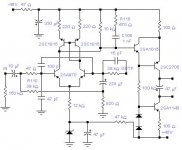The picture doesn't show up. You need to use the "attach file" at the bottom when you make a new post.
R110 is bootstraped to raise the input impedance. R118/C106 reduce high frequency gain in the second voltage amp, looks like 300Khz.
To raise the input impedance?!! I'd think that 150k resistor at the input would do that. 😱 I must be missing something here, or is the input impedance really 150k or more?. Please explain.
I'm trying to improve this amp by installing better parts. All resistors were standard 5% tolerance - replacing them with 1% metalfilms greatly improved soundstaging, and the highs sound slightly smoother (s for sibilance 🙂). I ordered some silmic caps to replace the existing bypasses (standard Elnas), and BB2604 opamps to replace the JRCs in the preamp.
It appears that a lot of global negative feedback is used in the power amp stage. As a result, the amp sounds too controlled and cold. When paired with a good set of speakers that can go really low, the amp sounds hard in the low range and slightly aggressive in the upper mids. With sealed bookshelf speakers the bass lines totally disappear and it sounds sterile. I was wondering if adding emitter degeneration resistors to the input pair, thus decreasing the OL gain and NFB, would loosen up the sound a bit and maybe give it a touch of warmth?
The output bias current was originally set to less than 5 mA. Cranking it up served no purpose - another proof of excessive global NFB. The amp actually sounded worse with the increased bias, with even more emphasized highs.
The resistor at the input is definitely 150KR. It seems to me that R110, along with the 820R resistor in the NFB leg, is connected parallel to the input resistor to bring down the input resistance to a reasonable value. Or am I oversimplifying things?
It appears that a lot of global negative feedback is used in the power amp stage. As a result, the amp sounds too controlled and cold. When paired with a good set of speakers that can go really low, the amp sounds hard in the low range and slightly aggressive in the upper mids. With sealed bookshelf speakers the bass lines totally disappear and it sounds sterile. I was wondering if adding emitter degeneration resistors to the input pair, thus decreasing the OL gain and NFB, would loosen up the sound a bit and maybe give it a touch of warmth?
The output bias current was originally set to less than 5 mA. Cranking it up served no purpose - another proof of excessive global NFB. The amp actually sounded worse with the increased bias, with even more emphasized highs.
The resistor at the input is definitely 150KR. It seems to me that R110, along with the 820R resistor in the NFB leg, is connected parallel to the input resistor to bring down the input resistance to a reasonable value. Or am I oversimplifying things?
- Status
- Not open for further replies.

